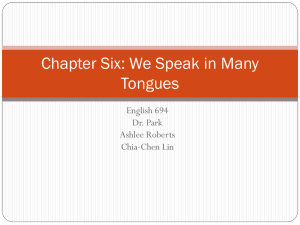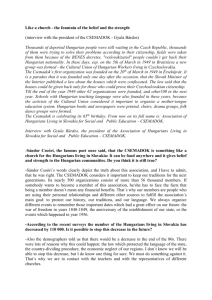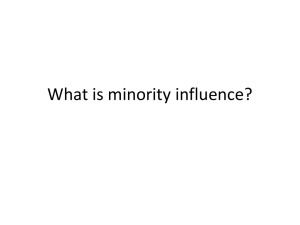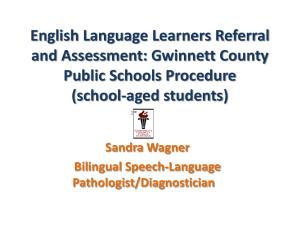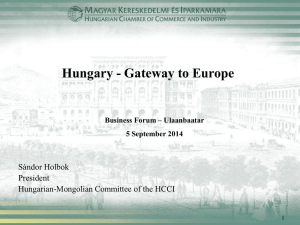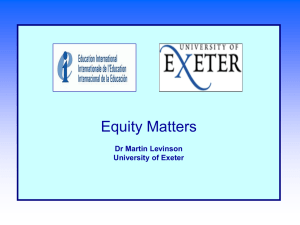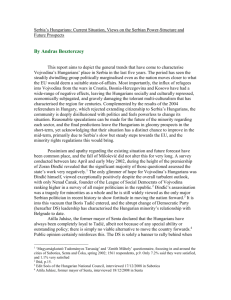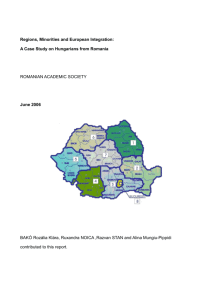ppt - UNEECC
advertisement
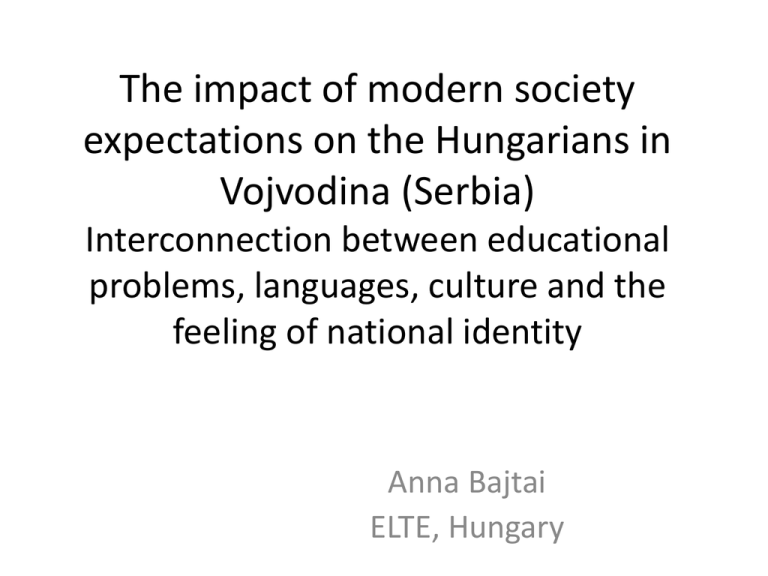
The impact of modern society expectations on the Hungarians in Vojvodina (Serbia) Interconnection between educational problems, languages, culture and the feeling of national identity Anna Bajtai ELTE, Hungary Aim • problems of the challenges of the modern society and the ‘survival’ of the new generations of Hungarians (as a national minority) in Vojvodina • between two fires: are supposed to comply with expectations of the state policy and traditional values of older generations (state policy ideological expectations: to be adaptable and successful citizens who are able to enjoy the guaranteed minority rights and same possibilities in every field of life as the members of the national majority of Serbia) Minority rights The most important needs for the ‘survival’ of a minority: usage of mother tongue + tradition nursing + education • can establish cultural, artistic and scientific institutions to preserve ethnic traditions (financially not supported by the state) • can have mother tongue education (preschool, primary and secondary school level) if there are more than 15 students interested • university level: train future teachers (+economists, some engineers and agronomists at universities supported by Hungary, but none in medical or legal fields) • official status if the population is over 15% Historical background • the second largest ethnic group in Vojvodina • settlements: northern parts -10th century southeastern parts – 18th century • Population: - 1890: 24,4% - 1910: 28,1% (Serbs 33.8%, Germans 21,4%) - 2002: 14,3% (290.207) • last 100 years: population halved • reasons: -low birth rate (23% decrease from 2002 to 2009) -assimilation -migration: Hungary, Germany, Austria, Switzerland, Canada -high number of mixed marriages (22.8%) Education data (2002 census) 14.28% of the population in Vojvodina was Hungarian (290.207) • 29.84% had a primary school degree • 37.29% had a secondary school degree • 3.23% had a college degree • 2.91% had a university degree (14.28% and 6%: disproportionate!) 2004 survey: • 3437 Hungarians at different universities and high schools in Serbia (→2035 in L1, 1402 in L2) • approximately 1000 students studying Hungary Between two fires: expectations and traditional values • Expectation of the state policy: adaptable and successful citizens -speak the state language (L2) with high proficiency -high education level (?) -knowledge , respect and acceptance of the history, literature, culture and traditions of the majority Between two fires: expectations and traditional values • Expectation of the older generation: to maintain the minority tradition -speak L1 with high proficiency -high education level -knowledge, respect and acceptance of the history, literature, culture and traditions of their own national (minority) group -to ‘remain’ Hungarian -to pass over the same tradition to the next generations (to raise their children as Hungarians) Why a dilemma? Childhood: • Early ages: focus on language acquirement (to learn to speak) • not ‘nationality specific’ knowledge acquirement (same steps of the process for every children in every country, from sounds to meaningful communication, only fairy tales and nursery rhymes refer to ethnic content) • free choice of language(s) by the family and immediate environment– one or both (without real consequences) • age 7: start of education • no bilingual schools (just parallel classes) • parents have to choose the language of instruction (L1 or L2) • it is not ‘just language’ • language of instruction determines the contents (national history, literature, cultural and tradition elements) • dilemma: - to preserve national identity emphasised by the elder generations (assured by L1) -or a smooth and quick assimilation into the ‘successful’ majority Arrays and diasporas: different characteristics and possibilities Characteristics Arrays: • live in Hungarian majority towns/villages • contact with L2: school (2-3 lessons/week) • television, music (receptive skills, passive knowledge) • mainly Hungarian dominant bilinguals Diasporas: • live in ethnically mixed towns/villages • an everyday contact with L2 +school • receptive & productive skills • mainly Serbian dominant bilinguals in towns (neighborhood + everyday life) • Hungarian dominant bilinguals in villages Possibilities and problems Arrays: • children can complete their studies in their mother tongue (primary and secondary school level) (→ parents and children are not ‘forced’ to choose between Hungarian and Serbian as the language of instruction) • in most settlements: L1 has official status and high prestige (high number of linguistic domains: private, social and official communication →can use L1 everywhere) • no natural input of L2 Possibilities and problems • children with L1 as the language of instruction cannot obtain appropriate language proficiency in state language because it is not taught as a foreign language →outdated teaching material and methodology: focus not on developing skills and competences, but on descriptive grammar and literature + no group differentiation (it is assumed children have the same level of proficiency in L2 in every part of Serbia); + the contents of the books can not be transposed to everyday communication Possibilities and problems Diasporas: • the variety of secondary school education in Hungarian language is limited (→ many parents decide to choose Serbian as the language of instruction for children when starting primary education in order to make their further education and assimilation easier) • in some settlements: no official status and lowering prestige →limited number of linguistic domains (at home)→ lower potential for survival Conclusions Arrays: • inappropriate language proficiency in L2 → inability to adapt and become a successful citizen → prevents social mobility → some (limited) number of college or university programs in L1 →can not compete with the native speakers if they choose other majors in L2 • choose to study and settle down in Hungary→ loss of the skilled university graduates Conclusions Diasporas: • limited number of secondary school programs in L1 • children often do not choose what they wish to study, because they can not study that in L1 → choose L2 as the language of instruction → loss of L1 →loss of cultural elements → change in the feeling of national identity (→ alerting for the older generations→ try to attract children to different tradition nursing groups) Bilingual schools: possible solution? • Aim: development of additive bilingualism (both languages of the same value, importance and prestige vs. subtractive bilingualism where the learning of L2 interferes with the learning of L1 and replaces it) →language retention and language enrichment →improve cross-cultural sensitivity →ensure the linguistic and ethnic equality between majority and minority students Conclusions: possible solution? • Can both phenomena (inappropriate level of proficiency in L2 and loss of L1) be stopped and diverted by the introduction of bilingual education? → would exempt parents from the pressure of forced choice → be able to acquire both languages and national contents attached to them simultaneously (preserve their mother tongue and culture + obtain higher competence in the state language) Possible failure of bilingual education? Arrays: • neither the majority nor the minority group would be interested enough →majority group: why should they? →minority group: L1 high prestige + possibilities in Hungary Diasporas: • fear of even faster assimilation • no professionals to carry out bilingual education Conclusions: a strange triangle of generations with intersects – problems still not solved Older generations: mostly concerned about the overall effect of language choice Parents: responsible for making the decision Children and the coming generations: bear the consequences of the decision Thank you for your attention!
